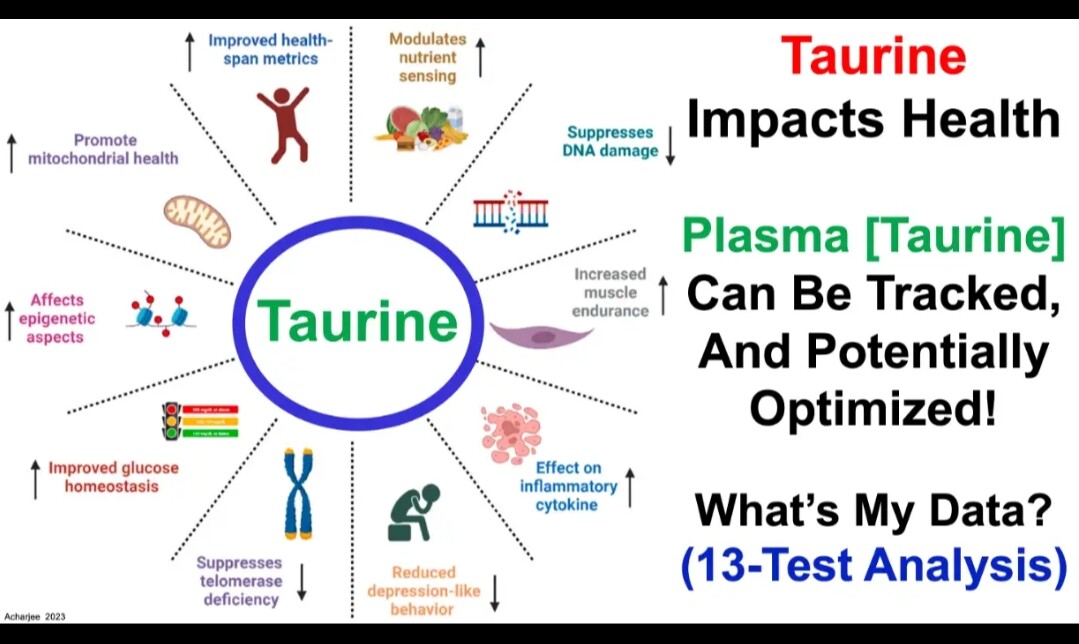Are these clinically significant? (it’s still good news but how good? ![]() )
)
On the fence, but I think the 5% increase in ejection fraction is pretty big
Yes, but how much? I don’t see that info anywhere. (I’m at about 8gm/day and noticing a number of positives.)
Taurine effects:
Blood pressure (SBP) reduced by 4 pts on avg.
Blood sugar reduced by 6 pts on avg.
Triglycerides reduced by 18 pts on avg!
Interesting new trial: Effects of Daily Taurine Intake for 6 Months on Biological Age and Body Metabolism Indicators As Well As Physical Fitness in 55-75-year-old Women and Men (TauAge)
Does a supplementation with 4 g of taurine daily over a period of 6 months slow down biological aging in humans? Researchers will compare supplementation with taurine to a placebo (a look-alike substance that contains no drug) to reliably determine whether taurine has an effect.
Results in 2026.
They may be taking too low of a dose. I’d say double it to 8 g if you want a good result with statistical significance. Small doses often end with middling results.
Interesting! Could be a total coincidence, but I recently ramped up my 1000mg of daily taurine to 3000mg (as a pit stop on the way to 6000).
Related or not, I have also noticed Oura has told me my heart rate while sleeping has lowered. I even googled some of my new medicines to see if that is a potential side effect.
Hard to know if this is related because I’m doing a few new things, but I read your post and squealed EUREKA
Also, @DrFraser Fyi
I find it interesting that there is a possible link between increased Taurine which increases Hydrogensulfide (H2S) which reduces TGF beta and which then suppresses IL-11.
- Taurine markedly increases hydrogen sulfide (H2S) in human subjects.
- And increased H2S significantly inhibits TGF beta and its downstream targets.
- Reduced TGF beta leads to reduced IL-11 (this since TGF beta is a stimulating factor of IL-11) .
So when it comes to reducing IL-11, maybe we should not focus too much on direct inhibitors but also look at upstream regulators, like reducing an over active TGF beta by Increased H2S through Taurine.
”Taurine has been shown to significantly increase hydrogen sulfide (H₂S) levels in the human body, particularly in individuals with prehypertension. A clinical trial indicated that a daily supplementation of 1.6 grams of taurine resulted in a near doubling of plasma H₂S levels, from 43.8 µmol/L to 87.0 µmol/L after 12 weeks of treatment.”
Hydrogen sulfide (H₂S) significantly influences the TGF-β/Smad signaling pathway, primarily through its inhibitory effects on TGF-β1 and its downstream targets, which are critical in processes like fibrosis.
Transforming growth factor-beta (TGF-β) significantly affects the production of interleukin-11 (IL-11) across various cell types, particularly in fibroblasts. In Humans.
Worth mentioning the ITP has tested an H2S prodrug 3 times, none of which were able to increase lifespan. Sodium thiosulfate—which can generate H2S under certain conditions—led to a 5% increase in male lifespan, just failing to meet the significance criteria (p=0.06).
TGF-β does play important physiological roles (wound healing, for example) and exerts anti-inflammatory effects (e.g suppression of pro-inflammatory cytokines and regulatory T cell activation), such that inhibition might lead to autoimmunity or tumorigenesis (after all, it’s considered an early-stage tumor suppressor). Because of this, it would preferable to selectively inhibit IL-11 rather than every factor downstream of TGF-β, especially since we know IL-11 is crucial for TGF-β-mediated fibrosis and can also independently regulate lifespan.
It would be nice if the ITP examined a see-saw approach to MTOR inhibition/promotion. One week, Rapamycin would inhibit MTOR, and the next, an MTOR activator would enhance muscle growth. I have a feeling that both MTOR inhibition and activation are good in moderation if alternated. The only way we would know is by trialing it.
When it come to interventions, there will always be trade offs. Do to much and it is detrimental. Do to little and it has no meaningful effect. When intervening with the right dose it usually comes with a known downside or at least a risk for negative unintended results.
Exercise and fasting are no exceptions. Dosing, timing, combinations of interventions will influence the effect. A net-negative or net-positiv.
